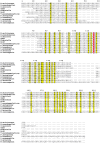Unveiling the role of BON domain-containing proteins in antibiotic resistance
- PMID: 39839116
- PMCID: PMC11747388
- DOI: 10.3389/fmicb.2024.1518045
Unveiling the role of BON domain-containing proteins in antibiotic resistance
Abstract
The alarming rise of antibiotic-resistant Gram-negative bacteria poses a global health crisis. Their unique outer membrane restricts antibiotic access. While diffusion porins are well-studied, the role of BON domain-containing proteins (BDCPs) in resistance remains unexplored. We analyze protein databases, revealing widespread BDCP distribution across environmental bacteria. We further describe their conserved core domain structure, a key for understanding antibiotic transport. Elucidating the genetic and biochemical basis of BDCPs offers a novel target to combat antibiotic resistance and restore bacterial susceptibility to antibiotics.
Keywords: BON domain-containing protein; antibiotic resistance; cell envelope; pathogens; structure and function.
Copyright © 2025 Sun and Chen.
Conflict of interest statement
The authors declare that the research was conducted in the absence of any commercial or financial relationships that could be construed as a potential conflict of interest.
Figures




References
Publication types
LinkOut - more resources
Full Text Sources

